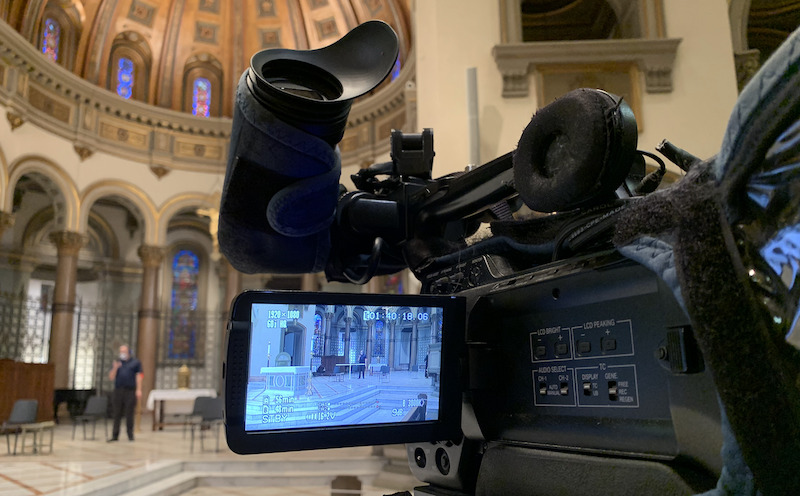Priest emphasizes ‘encounter with God’ in Keane lecture
How real are our virtual experiences? The question might have sounded paradoxical 20 years ago, but it’s one that has become increasingly relevant today.
Paulist Father Ricky Manalo, composer and author, addressed a crowd of around 100 people Friday, Dec. 4, at Immaculate Conception, Hampton, speaking on issues emerging from the intersection of faith, technology and the media.
The lecture, titled, “Onsite and Online: Catholic Worship and Technology in a 2.5 World,” was the first offered by the Bishop Keane Institute since the start of the pandemic.
“What defines authentic worship?” Father Manalo asked. “How has technology and the media reshaped our spiritual lives?”
“We can’t avoid the outside world,” he said. “We can’t take the iPhone away. We can for a while; we can put it in a basket. But it’s always there.”
Beyond four walls
Father Manalo began his examination of faith and technology with a trivia question.
“Who is the patron saint of television?” he asked.
The audience responded with surprised laughter at the idea that something we often think of as a stumbling block, rather than as an aid in our spiritual life, should have been assigned the honor of a patron.
But, indeed, it has one: St. Clare of Assisi, who, on Christmas Eve of 1252, found that she was too ill to leave her bed to attend Mass. She prayed to the Holy Spirit that she might take part, and the Lord granted her a vision, an image of the Mass projected on her bedroom wall.
It’s apropos, Father Manalo said, considering how many Catholics today find spiritual nourishment through televised Masses.
“My mother watches EWTN faithfully, every day,” he said. “That’s how she goes to Mass now.”
So questions of authenticity, of what constitutes real participation, are not as new as they may seem, he said. The issue was discussed as far back as 155, in fact, when Christian apologist and martyr, St. Justin, instructed the deacons of his community to take the Eucharist to those unable to attend Mass.
In a more contemporary example, Father Manalo spoke of his own childhood. Growing up in a family of six children, he said, it wasn’t unusual to be running late for church.
“My sister would always keep us waiting in the car,” he recalled, “so by the time we got there, we’d be relegated to the extension space. There was a sense of belonging, but not really; of being there, but not really being able to hear what was going on.”
“But yet, it ‘counted,’” he said, as the audience laughed again, this time in recognition of the experience, “because I was there.”
The anecdote, he said, speaks of a larger truth: namely that, wherever we are — physically, mentally or spiritually — Christ’s presence is never limited to the four walls of the church building.
“Whenever we celebrate the Mass, it’s not just about the people within those four walls,” he said. “It’s for everyone. For all people.”
Allow the world to enter
Conversely, the world does not remain outside of the walls of the church, nor of religious education classrooms.
In a postmodern world of competing narratives, he said, whenever something about the Catholic faith is taught, students are immediately connecting it with other ideas — with the Internet, pop culture, the perspectives of those they know from other backgrounds, other faiths.
“The four walls have become far more porous and flexible,” he said. “But that can be a good thing, too. They are relating what they learn to the world.”
Rather than ignoring technology and media, he said, Catholics can accompany students where they are. If a child is devoted to Marvel superheroes, for example, why not use that interest as a springboard for a broader conversation?
“What do they see in the characters? Can we find a Christian message there?” he asked.
In 2015, during Pope Francis’ visit to the Philippines, Father Manalo said, Cardinal Luis Antonio Tagle told a crowd of around 7,500 young adults to take their phones out at the end of the Mass.
“He said, ‘At the end of closing prayer, I want you to text someone out in the world, “Go out and proclaim the good news.” I’ll count to three, and then I want everyone to send it out.’”
The beauty of the gesture, Father Manalo said, is that the cardinal took a technology that the people were already using and gave it new meaning, turning text messages into thousands of calls to follow Christ.
Life in livestream
In the case of livestreamed Masses, Father Manalo said, “one way to look at it is, there’s a third space between the church building and our home, accessed through the camera.”
There is room for creativity in that third space, he said. Having children read along with Scripture passages during online Mass, typing in our intercessions, messaging fellow parishioners, even placing devotional items around the screen, are all ways to increase our sense of participation.
As a composer, Father Manolo said, he was inspired to include alternative verses to one of his most recent liturgical songs, “Christ’s Sacred Presence Knows No Bounds,” welcoming those watching at home.
“If my mother was there,” he said, “all of the sudden, they acknowledge her presence, and she’s a part of it.”
Livestreamed Masses aren’t a replacement for physical presence, he said, but they offer advantages, too — to the homebound and to those who are far from home.
“God is especially present in the Eucharist, but he is also present elsewhere,” Father Manalo said, noting livestreamed Masses as a tool of evangelization, giving those who have been away from Mass a simple step towards returning.
“In any worship experience, we begin with the encounter. It’s there in the story of Moses and the burning bush,” he said.
At its heart, the goal of worship is to bring people closer to God, whether within or without four walls.

